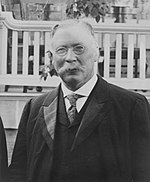The Alberta and Great Waterways Railway scandal was a political scandal in Alberta, Canada, in 1910. It resulted in the resignation of the provincial government of Alexander Cameron Rutherford over allegations of conflict of interest in the government's involvement in the financing of the Alberta and Great Waterways Railway. The scandal was instigated by the resignation of Public Works Minister William Henry Cushing from Rutherford's cabinet over disagreement with the government's railway policy, and its agreement with the Alberta and Great Waterways Railway company in particular. The Legislative Assembly of Alberta soon heard revelations of government favouritism towards the company, which had received a government charter to build a railway in northern Alberta, and a failure to oversee its operations properly. These revelations brought a large portion of Rutherford's Liberal caucus into revolt against his government, and he narrowly survived a sequence of attempts to topple his government. After his cabinet suffered further resignations, Rutherford placated the legislature by establishing a royal commission to investigate the affair. Rutherford's successor, Arthur Sifton, introduced legislation to undo many of Rutherford's actions. One piece of legislation, which provided for the confiscation from the Alberta & Great Waterways company of money raised by the sale of government-guaranteed bonds, was first opposed by many Rutherford loyalists in the legislature and then successfully challenged in court by the Royal Bank of Canada, which held much of the money on deposit. Though Sifton's government survived and would go on to win two provincial elections, the divisions in the Liberal party caused by the scandal would not fully heal for years.
Recently selected: NSB Gjøvikbanen - 2008 Chatsworth train collision - Flekkefjord Station
